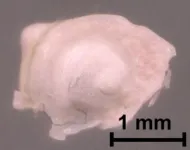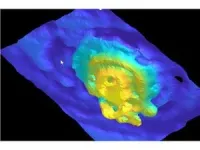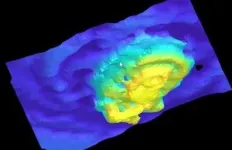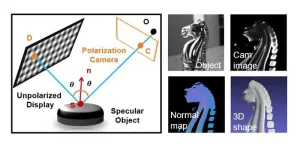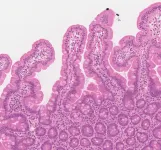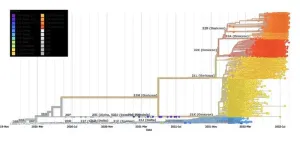(Press-News.org) WASHINGTON — For the first time, researchers have shown that terahertz imaging can be used to visualize internal details of the mouse cochlea with micron-level spatial resolution. The non-invasive method could open new possibilities for diagnosing hearing loss and other ear-related conditions.
“Hearing relies on the cochlea, a spiral-shaped organ in the inner ear that converts sound waves into neural signals,” said research team leader Kazunori Serita from Waseda University in Japan. “Although conventional imaging methods often struggle to visualize this organ’s fine details, our 3D terahertz near-field imaging technique allows us to see small structures inside the cochlea without any damage.”
Terahertz radiation, which falls between microwaves and the mid-infrared region of the electromagnetic spectrum, is ideal for biological imaging because it is low-energy and non-harmful to tissues, scatters less than near-infrared and visible light and can pass through bone while also being sensitive to changes in hydration and cellular structure.
In Optica, Optica Publishing Group’s journal for high-impact research, a multi-institutional group of researchers describe their 3D terahertz near-field imaging technique, which provides high-resolution images that can be used to create detailed 3D reconstructions.
“With further development, this technique could lead to a new diagnostic method for ear diseases that have been difficult to diagnose until now,” said Serita. “It has the potential to enable on-site diagnosis of conditions like sensorineural hearing loss and other ear disorders. It might also be useful for early detection of hearing impairments, allowing earlier treatment and better outcomes.”
Creating a tiny light source
Serita was inspired to develop the technique after learning about cochlear measurement challenges from coauthor Takeshi Fujita from the Department of Otolaryngology-Head and Neck Surgery at Kobe University. “That got me thinking — maybe terahertz imaging could help solve these issues,” said Serita. “We decided to collaborate and explore this idea together. The big question was whether we could visualize the tiny internal structures of the cochlea without causing any damage.”
Terahertz imaging is typically performed by focusing terahertz waves using a lens made for these wavelengths. However, these lenses are typically limited to focal sizes measuring a few millimeters — too large to image the tiny structures of the cochlea. In the new work, the researchers eliminated the need for a focal lens by using a nonlinear optical crystal to create terahertz light emitting from a very small region within the crystal. Because this terahertz point source had a beam diameter of just 20 microns, the researchers could measure much smaller samples with terahertz waves.
"Until now, there was no way to observe the internal structure of the cochlea non-destructively with high resolution,” said Serita. “A key innovation in our work was the use of a nonlinear optical crystal to generate terahertz waves from 1560-nm near-infrared light. This was crucial for our imaging technique.”
Visualizing cochlear structures
To test their new approach, the researchers first needed to confirm that the terahertz waves were reaching the inside of the cochlea. They did this by using the terahertz imaging setup to conduct experiments using two different extracted and dried mouse cochlear samples — one with an empty interior and another filled with a metal material that reflects terahertz waves. They observed clear differences between the two samples, confirming that the terahertz waves were penetrating the inside of the cochlea.
The researchers then showed that internal structural information could be easily observed and extracted from 2D terahertz time-domain images using an unsupervised learning algorithm. The team also used the setup to successfully carry out 3D terahertz time-of-flight imaging and 3D reconstruction, allowing visualization of part of the cochlear duct, the spiral structure inside the cochlea.
Next, the researchers plan to demonstrate the technique’s feasibility on cochleae in a more realistic biological environment. Since the cochlea is located deep inside the ear and filled with lymphatic fluid, they will first need to miniaturize the system so it can be inserted through the ear canal. They are also developing a stronger terahertz source to reach deeper structures.
The researchers say that once the terahertz imaging technology is miniaturized, it could be incorporated into endoscopes and otoscopes, enabling non-invasive in vivo imaging for cochlear diagnostics and early cancer detection in various organs.
Paper: L. Zheng, H. Chen, T. Fujita, A. Kakigi, N. Allen, H. Murakami, M. Tonouchi, K. Serita, “Three-dimensional terahertz near-field imaging evaluation of cochlea”
DOI: 10.1364/OPTICA.543436.
Media Contacts:
Aaron Cohen
(301) 633-6773
aaroncohenpr@gmail.com
mediarelations@optica.org
END
Terahertz imaging reveals new views of internal cochlear structure
Non-destructive micron-resolution imaging of cochlea lays groundwork for better hearing loss diagnosis
2025-03-27
ELSE PRESS RELEASES FROM THIS DATE:
Machine learning program enhances transplant risk assessment in myelofibrosis patients better than current models
2025-03-27
(WASHINGTON—March 27, 2025) — A machine learning model generated by a team from the European Society for Blood and Marrow Transplantation (EBMT) outperformed standard statistical models in identifying and stratifying transplant risk for patients with myelofibrosis, according to new research published today in Blood, the American Society of Hematology’s flagship journal.
“Although there are many models available to identify patients with high-risk myelofibrosis, we are still lacking ...
Beyond ambiguous reflections: Bridging optical 3D metrology and computer vision
2025-03-27
Accurate and robust 3D imaging of specular, or mirror-like, surfaces is crucial in fields such as industrial inspection, medical imaging, virtual reality and cultural heritage preservation. Yet anyone who has visited a house of mirrors at an amusement park knows how difficult it is to judge the shape and distance of reflective objects.
This challenge also persists in science and engineering, where the accurate 3D imaging of specular surfaces has long been a focus in both optical metrology and computer vision research. While specialized techniques ...
Baylor Anthropology scientist Julie Hoggarth, Ph.D., named AAAS Fellow
2025-03-27
Noted Maya archaeologist Julie Hoggarth, Ph.D., associate professor of anthropology at Baylor University, has been elected to the rank of AAAS Fellow, a lifetime honor announced today by the Council of the American Association for the Advancement of Science (AAAS), the world’s largest general scientific society and publisher of the Science family of journals.
Hoggarth is among the 471 scientists, engineers and innovators who have been elected 2024 Fellows for their scientifically and socially distinguished achievements throughout their careers. The new Fellow class hails from academic institutions, ...
Joint clinical commitment will advance integration of telehealth, value of patient care
2025-03-27
DALLAS, March 27, 2025 — Recent analysis by the National Health Institute indicates that telehealth now accounts for 23% of all health care encounters nationwide, with some clinical specialties reporting virtual visit rates now exceeding 50%.[1] To help ensure quality care in this rapidly expanding field, the American Heart Association Center for Telehealth and the National Institutes of Health-funded University of North Carolina Chapel Hill Center for Virtual Care Value and Excellence (UNC-Chapel Hill ViVE), are building ...
The Protein Society announces its 2025 Award Recipients
2025-03-27
FOR IMMEDIATE RELEASE
Contact:
Raluca Cadar
The Protein Society
Phone: (844) 377-6834
E-mail: rcadar@proteinsociety.org
LOS ANGELES, CA – The Protein Society, the premier international society dedicated to supporting protein research, announces the winners of the 2025 Protein Society Awards, which will be recognized at the 39th Annual Symposium, June 26 – 29, 2025, in San Francisco, USA. Plenary talks from award recipients will take place throughout the 3.5-day event. The winners’ scientific accomplishments, described by their nominators below, demonstrate their profound impact on protein science.
The Christian B. Anfinsen ...
AI is as good as pathologists at diagnosing celiac disease, study finds
2025-03-27
A machine learning algorithm developed by Cambridge scientists was able to correctly identify in 97 cases out of 100 whether or not an individual had coeliac disease based on their biopsy, new research has shown.
The AI tool, which has been trained on almost 3,400 scanned biopsies from four NHS hospitals, could speed up diagnosis of the condition and take pressure off stretched healthcare resources, as well as improving diagnosis in developing nations, where shortages of pathologists are severe.
Digital ...
AI could help sonographers identify abnormalities in unborn babies more quickly
2025-03-27
Artificial intelligence (AI) could help sonographers identify any abnormalities at the 20-week pregnancy screening scan almost twice as quickly, without reducing the accuracy or reliability of diagnoses, a new study has shown.
This will help improve patient care by allowing sonographers to focus on other aspects of the scan, such as communicating with parents or spending more time looking at any areas of concern.
The trial is the first of its kind to use AI for the 20-week pregnancy scan on real patients, and is ...
First clinical trial of an AI therapy chatbot yields significant mental health benefits
2025-03-27
Dartmouth researchers conducted the first clinical trial of a therapy chatbot powered by generative AI and found that the software resulted in significant improvements in participants' symptoms, according to results published March 27 in the New England Journal of Medicine AI.
People in the study also reported they could trust and communicate with the system, known as Therabot, to a degree that is comparable to working with a mental-health professional.
The trial consisted of 106 people from across the United States diagnosed with major depressive disorder, generalized anxiety disorder, or an eating disorder. ...
AI learns to ‘speak’ genetic ‘dialect’ for future SARS-CoV-2 mutation prediction
2025-03-27
It’s been five years since COVID-19 was declared a global pandemic. As SARS-CoV-2 shifts to endemic status, questions about its future evolution remain. New variants of the virus will likely emerge, driven by positive selection for traits such as increased transmissibility, longer infection duration and the ability to evade immune defenses. These changes could allow the virus to spread among previously immunized populations, potentially triggering new waves of infection.
Predicting new mutations in viruses is crucial for advancing life science research, particularly when trying to understand how viruses evolve, ...
$50 million gift from the Weill Family Foundation establishes the Weill Cancer Hub East
2025-03-27
New York, N.Y., and Princeton, N.J. (March 27, 2025)—With a mission to understand how nutrition and metabolism impact the body’s ability to control cancer, four leading research institutions have united under the Weill Cancer Hub East, an innovative, collaborative partnership that aims to transform cancer treatment. The initiative connects world-class experts from Princeton University, The Rockefeller University, Weill Cornell Medicine and the Ludwig Institute for Cancer Research to enhance a ...
LAST 30 PRESS RELEASES:
School feeding programs lead to modest but meaningful results
Researchers develop AI Tool to identify undiagnosed Alzheimer's cases while reducing disparities
Seaweed based carbon catalyst offers metal free solution for removing antibiotics from water
Simple organic additive supercharges UV treatment of “forever chemical” PFOA
£13m NHS bill for ‘mismanagement’ of menstrual bleeds
The Lancet Psychiatry: Slow tapering plus therapy most effective strategy for stopping antidepressants, finds major meta-analysis
Body image issues in adolescence linked to depression in adulthood
Child sexual exploitation and abuse online surges amid rapid tech change; new tool for preventing abuse unveiled for path forward
Dragon-slaying saints performed green-fingered medieval miracles, new study reveals
New research identifies shared genetic factors between addiction and educational attainment
Epilepsy can lead to earlier deaths in people with intellectual disabilities, study shows
Global study suggests the underlying problems of ECT patients are often ignored
Mapping ‘dark’ regions of the genome illuminates how cells respond to their environment
ECOG-ACRIN and Caris Life Sciences unveil first findings from a multi-year collaboration to advance AI-powered multimodal tools for breast cancer recurrence risk stratification
Satellite data helps UNM researchers map massive rupture of 2025 Myanmar earthquake
Twisting Spins: Florida State University researchers explore chemical boundaries to create new magnetic material
Mayo Clinic researchers find new hope for toughest myeloma through off-the-shelf immunotherapy
Cell-free DNA Could Detect Adverse Events from Immunotherapy
American College of Cardiology announces Fuster Prevention Forum
AAN issues new guideline for the management of functional seizures
Could GLP-1 drugs affect risk of epilepsy for people with diabetes?
New circoviruses discovered in pilot whales and orcas from the North Atlantic
Study finds increase in risk of binge drinking among 12th graders who use 2 or more cannabis products
New paper-based technology could transform cancer drug testing
Opioids: clarifying the concept of safe supply to save lives
New species of tiny pumpkin toadlet discovered in Brazil highlights need for conservation in the mountain forests of Serra do Quiriri
Reciprocity matters--people were more supportive of climate policies in their country if they believed other countries were making significant efforts themselves
Stanford Medicine study shows why mRNA-based COVID-19 vaccines can cause myocarditis
Biobanking opens new windows into human evolution
Sky-high smoke
[Press-News.org] Terahertz imaging reveals new views of internal cochlear structureNon-destructive micron-resolution imaging of cochlea lays groundwork for better hearing loss diagnosis
